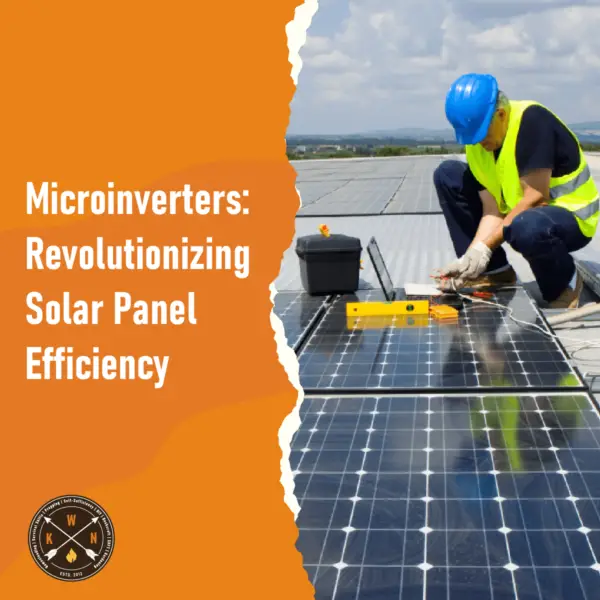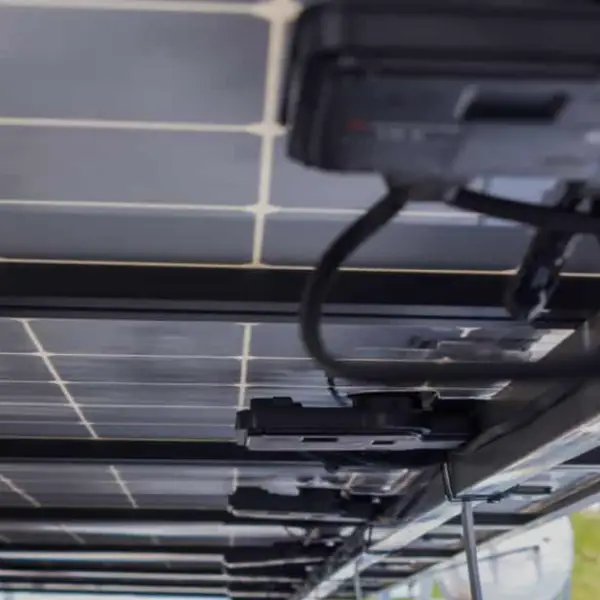
Are you venturing into the world of solar energy and scratching your head about choosing the right inverter? Perhaps you’re feeling overwhelmed by the jargon and options, maybe even a bit embarrassed to ask what might seem like a basic question? You aren’t alone.
Let’s clear up the confusion around microinverters and discover if they are the perfect fit for your power needs. It’s time to explore everything you should know about solar power and how these little devices play a big part in powering our future.
Table of Contents
ToggleMicroinverters vs. String Inverters
The two main types of solar inverters available are string inverters and microinverters. Choosing the correct solar inverter can greatly affect your entire solar installation. Understanding these components can affect how your panel installation performs.
Traditional string inverters connect multiple solar panels in a series to a single, central inverter. This is usually installed on a wall, often in a garage. Microinverters are installed individually to each solar panel.
One benefit of microinverters is that they allow each individual panel to operate independently. It can boost your solar panel systems efficiency, converting direct current (DC) to alternating current (AC) electricity right on your roof. But which system works best for you?

Advantages of Using Microinverters for Solar Energy
Microinverters are quickly becoming a popular option for those wanting to make the move to solar energy. There are many advantages for doing so when you consider all your power needs. Let’s consider a few perks of using individual solar panels.
Panel-Level Monitoring for Individual Solar Panels
One huge perk of using microinverters is the ability to keep tabs on each individual panel. This is thanks to panel-level monitoring. Should any problems arise, microinverters offer real-time performance data, allowing you to know the precise location of the issues.
You don’t have to play the guessing game trying to figure out the source of any efficiency setbacks you might face. With insight down to each individual solar panel, troubleshooting is very simple.
Greater Flexibility in System Design for Your Entire Solar System
Thinking of expanding your solar panel system in the future? Microinverters give homeowners more flexibility when adding individual solar. You can easily add individual panels, and don’t worry about needing to match an existing central inverter.
You don’t have to rework your complete setup or make costly alterations. This modular approach allows easy custom design options when you get your solar kit.
Better Performance Under Shaded Conditions
Shading from trees, chimneys, or other obstructions can significantly impact the efficiency of a string inverter system. Shading just one panel in a series can reduce the output of the entire string.
Microinverters bypass this problem by allowing each panel to perform separately. A shady spot on one panel doesn’t impact the productivity of others.
Longer Lifespan and Durability
Solar panels typically come with a warranty of around 25 years. You’ll be glad to know most microinverters have warranties that can last just as long. So choosing them will make your choice worth it over the long run.
In comparison, string inverters may need replacing during the same time frame, leading to extra costs for maintenance. The initial costs might be higher, but microinverters have a high chance of lasting.
Enhanced Safety Features for Solar Installations
Microinverters offer big safety boosts compared to traditional string inverters. Because microinverters convert DC power to AC power right on the roof, they reduce the risks of high-voltage DC wiring running inside the home.
If there’s an emergency, systems with microinverters come with built-in rapid shutdown functions, thus ensuring more safety for both homeowners and any first responders.
Potential Drawbacks of Microinverters
Although microinverters have great benefits, it’s good to consider all angles and determine any downsides before leaping in. Here are a few things to consider. Let’s think through these things together so you are set up for success.
Higher Upfront Cost for Initial Solar Investment
Typically, installing a solar panel system with microinverters ends up costing more upfront. That’s mainly because each individual solar panel needs its own inverter.
And since the costs of individual microinverters add up, this might be the deal breaker for anyone on a strict budget when switching over to power solar. But before dismissing them completely, think about the long-term. The enhanced performance, extended warranties, and lower maintenance could provide you much value in the long run.
Complexity of Installation and Maintenance in the Long-Term
Installing microinverters can be trickier compared to installing a central string inverter. Each panel has to be linked up, and this might call for specialized skills and more time to set things up. Servicing them can also prove difficult because microinverters are on the roof.
The use of microinverter accessories, such as specialized mounting brackets and cabling, also adds to the complexity. This often leads to higher labor costs during the initial solar installations.
Lower Power Output per Unit Compared to String Inverter Setups
Microinverters are great for many residential setups. They aren’t quite as useful when considering bigger commercial or industrial projects. The smaller power output of individual microinverters may restrict just how many panels one system handles, when it comes to huge energy needs.
For bigger applications, string inverters may offer a more practical means of reaching the power outcome needed without adding numerous components. It depends on your overall power needs.
Choosing the Right Microinverter for Solar Kits
If you’re in the market for microinverters, make sure they suit your needs and budget. Take a look at what different brands have to offer before taking the leap. Here are some things you’ll want to remember when purchasing your solar kits.
Key Specifications to Consider When Picking Individual Panels
When selecting a microinverter, consider these crucial specs, since each individual solar panel is a factor. Consider the inverter’s efficiency to measure just how much power gets turned from DC to AC, something vital to maximize the system’s efficiency of your individual panel. Take a look at just how big a microinverter is; make sure it suits how much power the panels generate without too much clipping.
A single-phase system, with power running through a live wire, often costs less and works well for lots of houses. A three-phase setup boosts performance by sending more power across three live wires; this is well worth considering if your power use is really high. It is critical to consider microinverter accessories that work best for the entire solar project as well.
Considering the voltage and current ratings of the microinverters is also very important. The microinverters should be compatible with the specific solar panels you plan to use. Overlooking these specifications could lead to system underperformance or, in severe cases, equipment damage.
Top Brands in the Microinverter Market
When it comes to microinverters, you have many brands, each known for their own features. Enphase is seen as the leader with great tech and dependability. The Enphase IQ8 series stands out since it can keep a microgrid going when the power goes off.
Hoymiles gives many microinverters for linking up to one, two, or even four panels. APsystems builds microinverters for both single-phase and three-phase setups, along with tools to watch how everything performs in real time. You can subscribe to their newsletter to keep up to date.
When comparing microinverter companies, also consider their warranty terms, customer support, and any additional features they offer, such as energy storage integration. This ensures you select a brand that provides not just a product, but a comprehensive support system for your solar investment.
Installation and Maintenance Tips for Solar Power Systems
When you decide to install microinverters, the goal is to ensure peak efficiency and make your investment worth it. Knowing the correct methods of setting them up and ensuring everything is watched over helps significantly. Here’s how to keep your microinverters in great shape.
Proper Installation Procedures for your Solar Panel Systems
Start by bringing in expert installers with microinverter know-how. These people will ensure that the individual solar panels hook up safely and precisely. They’ll also figure out the best places for the panels.
Plus, they can take care of all electrical links by sticking to local rules to offer top safety. This includes verifying the proper grounding and surge protection to safeguard the equipment from electrical anomalies. Proper installation from the start prevents issues down the road and helps with long-term solar power.
Regular Maintenance to Maximize the System’s Efficiency
Watch over your microinverters often to confirm that all panels perform without fail. Take a look at the data coming from the tracking tools so you can catch any decrease early.
Quickly tidy up your panels and get rid of any trash. You’ll maintain your panels in tip-top shape by simply ensuring they are tidy and have sunlight. Also, verify the structural integrity of the mounting system and check for any signs of wear or corrosion to keep everything working well.
Regular maintenance not only improves your system’s efficiency but also increases its lifespan. This saves you money and boosts the system’s overall performance over time.
Troubleshooting Common Issues
Have a plan to spot and deal with common troubles, which includes connection hiccups or odd numbers being reported by tracking software. Consult an expert and look through your microinverter’s manual for fixes, which will tackle the problems head-on.
Should your gear stop running correctly, it might have to get checked and serviced by folks with formal training. Consider keeping a log of performance metrics and maintenance activities. This helps with future troubleshooting and can be valuable if warranty claims are needed.
Having a well-documented history of your system can also aid technicians in diagnosing and fixing issues quicker, saving time and resources.
| Issue | Possible Cause | Troubleshooting Tip |
|---|---|---|
| Low power output from a panel | Shading, dirt accumulation, or microinverter failure | Clear the panel, check the microinverter connection, and check monitoring data. |
| Communication errors | Loose connections, wiring issues, or gateway problems | Check all connections, reboot the gateway, or call the support team. |
| Microinverter not reporting | Power interruption, device failure | Ensure the microinverter has power and test its performance during sunlight. |
Real-World Examples and Case Studies of Energy Efficiency
Solar energy can really help individual panels shine and assist a lot. Let’s consider the numbers as one of the key ingredients of the panel’s output. See below a bit of practical data that underscores the advantages of using multiple panels.
Increased Energy Production
Take the story of a home that hooked up microinverters with 3.3kW. Their energy creation shot up by roughly 15% annually, something that tackled issues relating to shading brought on by some trees.
And thanks to the efficiency boost, that home made much more energy than earlier estimated, which made the owner very happy. This demonstrates how microinverters can maximize energy production even under less-than-ideal conditions.
The homeowner also took advantage of available government incentives and rebates to further reduce their initial investment. These incentives made the decision to install microinverters even more financially appealing.
Enhanced Monitoring and Maintenance
A university put a sizable solar array together, hooking it up with microinverters. The central checking instruments from the system noted a failure happening in one of its units fast.
And due to prompt swap-out of the microinverter, the institution sidestepped greater breakdowns and kept its operational efficiency levels at almost 100%, showing why precise tracking proves key. The panel-level monitoring capabilities of microinverters allow for quicker identification and resolution of issues.
This proactive approach to maintenance minimizes downtime and ensures continuous, high-level performance of the entire solar array. This also helps prevent minor issues from escalating into major, costly repairs.
Long-Term Cost Savings and Environmental Benefits for Individual Panels
When you look at another look at an eco-focused office group in California that picked microinverters, they learned something quite valuable. At the end of 25 years, that facility ended up saving a good amount on utility costs and also brought down carbon footprint by nearly 40%.
These returns illustrate just how great they may turn out once those individual solar panels start producing efficiently with less trouble over many decades. These long-term savings and environmental benefits highlight the sustainability and economic viability of using individual panels in commercial settings.
The office group also invested in solar batteries to store excess energy generated during peak hours, further reducing their reliance on the grid. This move toward greater grid independence not only lowered their energy costs but also enhanced their resilience during power outages.
Government Incentives and Rebates
Homeowners can greatly decrease the costs by picking microinverters as part of solar installations. This is possible thanks to beneficial government incentives along with tax rebates that substantially boost these tech products in society.
Federal Tax Credits and Local Rebates to get Individual Solar
In the United States, those putting individual solar panel systems together might get money back via a Federal Tax Credit. You get about 26% off certain prices related to adding panels like this as a tax credit, leading directly towards lessening prices overall, once set up.
Then add up regional plans or offers along with federal perks so owners have a great path. It makes going eco easier for those looking at less hassle during installations plus bigger short-run wins. In addition to federal tax credits, many states and local governments offer additional incentives.
These can include rebates, grants, and performance-based incentives. These incentives are designed to encourage homeowners and businesses to adopt solar energy and further reduce the financial burden of solar installations.
Impact on Home Value and Grid Independence for Individual Panels
It can substantially impact the value of a house and further grid independence by adding in microinverters to that solar panel arrangement, along with encouraging environmentally friendly methods in an easy format for use. Going all-green makes you set out easily as somebody ready or willing enough today who wants only long haul financial protection blended easily inside one solid design. You boost prices should you have an aim.
Long-Term Economic Benefits of Microinverters
Thinking of microinverters as investments makes sense considering not just the prices drop regarding utility bills but even improving at that residential assessment to pull in extra buyer fascination. If folks focus upon eco tech along solar choices, it grows in desire – thereby giving more opportunities when a selling goal enters minds.
It’s important to factor in the potential for increased property value when considering microinverters for a home solar system. A solar-equipped home is an attractive feature for potential buyers. This often results in a higher selling price compared to similar properties without solar installations.
Homes equipped with microinverter systems may also benefit from lower electricity bills over time, enhancing their long-term appeal to eco-conscious buyers.
Increasing Home Value through Individual Panels
It often adds resale benefit through improving market desirability if someone uses their property to generate eco minded results. Making positive impacts on property desirability shows today to have improved marketplace attractiveness within most communities everywhere to improve results more successfully without delay in the selling objective for years here forth-right once executed and all done.
Studies have shown that homes with solar panels sell for a premium compared to non-solar homes. The amount of the premium can vary based on location, system size, and other factors, but the trend is clear. Potential buyers recognize the value of lower energy bills and a reduced carbon footprint, making solar-equipped homes more desirable.
This increase in demand can translate into a higher sale price and a quicker sale. The return on investment from a microinverter system can be significant, considering both the energy savings and the potential increase in property value.
Achieving Grid Independence
Creating self made vitality allows houses never to rely mainly just only using local main line transmission setups that always keeps those fees reduced alongside getting assurance since no outside sources now are controlling costs- letting long durability along fiscal wellness spread well as folks reside peacefully by keeping those savings over periods that provide the best financial protection today or throughout coming times effectively.
By generating your own electricity, you reduce your dependence on the utility grid and shield yourself from fluctuating energy prices. This energy independence provides peace of mind and greater control over your energy costs. Homes with solar panels and microinverters can even achieve net-zero energy consumption, where they produce as much energy as they consume over the course of a year.
This level of grid independence not only saves money but also contributes to a more sustainable and resilient energy system. Surplus energy can be sold back to the grid through net metering programs, providing additional financial benefits and supporting the growth of renewable energy.
FAQs about microinverters
What do microinverters do?
Microinverters convert the DC electricity that solar panels generate into AC electricity, which is the type used in homes and businesses. Microinverters operate at the level of an individual panel, maximizing the energy harvested from each panel and sending real-time updates on system performance.
What are the disadvantages of a micro inverter?
There are a few downsides to microinverters, like higher initial cost than standard string inverters. The roof mounting also makes maintenance and repairs complex.
The output is typically lower than what panels generate, but these are tradeoffs against the flexibility, monitoring and efficiency benefits.
Is a microinverter better than an inverter?
It really depends on what you’re hoping to achieve with individual panels. If shade plays a role and your roofs face differing directions, microinverters likely have the advantage over a traditional string inverter.
If shading isn’t a problem, string inverters provide a very economical solar energy installation choice. It’s important to consider the specific conditions of your property and your energy goals when making a decision.
Can you mix IQ7 and IQ8 microinverters?
Yes, typically you can mix IQ7 and IQ8 microinverters. Check compatibility with an expert. Expand your existing IQ7 systems by installing IQ8 Microinverters. Compatibility is influenced by regulatory requirements, grid configurations, and energy storage system design.
Conclusion
So, after thinking through this process together, do microinverters make sense for your needs? Whether it’s better output in shady spots, expandability, or those lengthy guarantees that catch you – hopefully it made you feel sure of yourself with any solar arrangement project for those independent folks and those grid-collapse wary folks.
All you do can deliver lasting electricity alongside sustainability. So take all things from solar kits, plus systems carefully so a step soon ensures homes stay boosted from those sun resources in coming phases through these amazing technologies.




